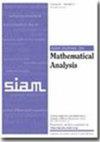Existence of Solutions for a Class of One-Dimensional Models of Pedestrian Evacuations
IF 1.9
2区 数学
Q1 MATHEMATICS, APPLIED
引用次数: 0
Abstract
SIAM Journal on Mathematical Analysis, Volume 56, Issue 3, Page 3386-3411, June 2024.Abstract. Pedestrian evacuation in a corridor can de described mathematically by different variants of the model introduced by R. L. Hughes [Transp. Res. Part B Methodol., 36 (2002), pp. 507–535]. We identify a class of such models for which existence of a solution is obtained via a topological fixed point argument. In these models, the dynamics of the pedestrian density [math] (governed by a discontinuous-flux Lighthill, Whitham, and Richards model [math]) is coupled to the computation of a Lipschitz continuous “turning curve” [math]. We illustrate this construction by several examples, including the Hughes model with affine cost (a variant of the original problem that is encompassed in the framework of El-Khatib, Goatin, and Rosini [Z. Angew. Math. Phys., 64 (2013), pp. 223–251]. Existence holds either with open-end boundary conditions or with boundary conditions corresponding to panic behavior with capacity drop at exits. Other examples put forward versions of the Hughes model with inertial dynamics of the turning curve and with general costs.
一类一维行人疏散模型解的存在性
SIAM 数学分析期刊》,第 56 卷,第 3 期,第 3386-3411 页,2024 年 6 月。 摘要。走廊中的行人疏散可以用 R. L. Hughes [Transp. Res. Part B Methodol.我们确定了一类这样的模型,通过拓扑定点论证可以得到解的存在性。在这些模型中,行人密度的动态[数学](由非连续流动的莱特希尔、惠瑟姆和理查兹模型[数学]控制)与利普斯奇兹连续 "转弯曲线 "的计算[数学]相耦合。我们用几个例子来说明这一构造,包括具有仿射成本的休斯模型(El-Khatib、Goatin 和 Rosini [Z. Angew. Math. Phys.在开端边界条件或与出口处容量下降的恐慌行为相对应的边界条件下,存在性都是成立的。其他例子提出了具有转弯曲线惯性动力学和一般成本的休斯模型版本。
本文章由计算机程序翻译,如有差异,请以英文原文为准。
求助全文
约1分钟内获得全文
求助全文
来源期刊
CiteScore
3.30
自引率
5.00%
发文量
175
审稿时长
12 months
期刊介绍:
SIAM Journal on Mathematical Analysis (SIMA) features research articles of the highest quality employing innovative analytical techniques to treat problems in the natural sciences. Every paper has content that is primarily analytical and that employs mathematical methods in such areas as partial differential equations, the calculus of variations, functional analysis, approximation theory, harmonic or wavelet analysis, or dynamical systems. Additionally, every paper relates to a model for natural phenomena in such areas as fluid mechanics, materials science, quantum mechanics, biology, mathematical physics, or to the computational analysis of such phenomena.
Submission of a manuscript to a SIAM journal is representation by the author that the manuscript has not been published or submitted simultaneously for publication elsewhere.
Typical papers for SIMA do not exceed 35 journal pages. Substantial deviations from this page limit require that the referees, editor, and editor-in-chief be convinced that the increased length is both required by the subject matter and justified by the quality of the paper.

 求助内容:
求助内容: 应助结果提醒方式:
应助结果提醒方式:


